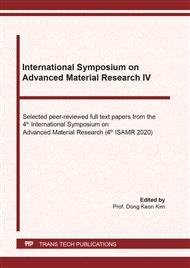p.13
p.18
p.24
p.30
p.35
p.41
p.47
p.52
p.58
Amine-Based Carbon Dioxide Capture: Densities of CO2-Loaded Monoethanolamine Aqueous Solution at 10 to 90 °C
Abstract:
The global warming phenomenon has led to world climate change caused by high concentrations of greenhouse gases (GHG) especially carbon dioxide (CO2) in the atmosphere. Carbon dioxide is produced in large quantities from fuel combustions, gas sweetening processes, etc. Since its emission rises annually, some efforts to reduce the emission are, therefore, required. Monoethanolamine (MEA), a primary amine, has been widely used for many years for acid gas removal. To get a better column performance, an accurate physical properties measurement, such as density, needs to be conducted. This study aims to measure the densities of 10 wt.% MEA aqueous solutions at temperatures from 10 to 90 °C and CO2 loadings up to 0.417 mol CO2/mol MEA. The results show that the higher the concentration of CO2 the higher the density at a constant temperature, while the densities decrease as temperatures increase due to volumetric expansion. Besides, an expression to correlate the densities of 10 wt.% MEA aqueous solutions was also developed based on the pure-component molar volumes together with the excess molar volumes. The average error of the measurement was found to be 0.18%.
Info:
Periodical:
Pages:
47-51
Citation:
Online since:
June 2021
Authors:
Keywords:
Price:
Сopyright:
© 2021 Trans Tech Publications Ltd. All Rights Reserved
Share:
Citation:


